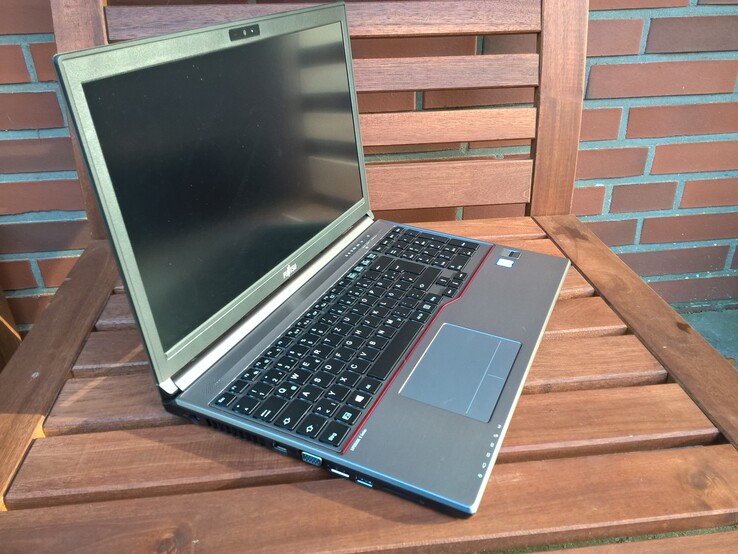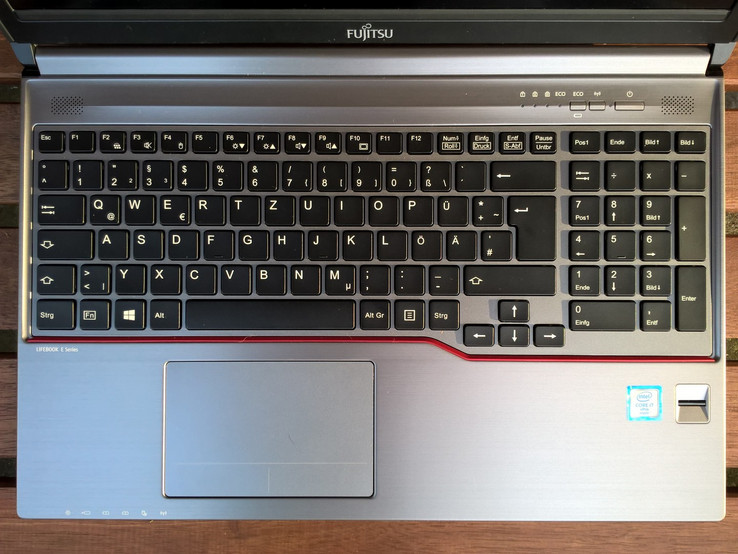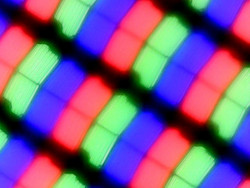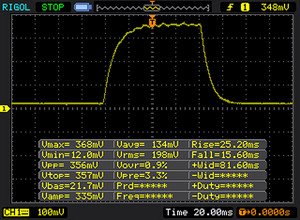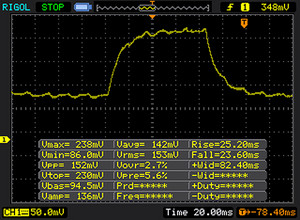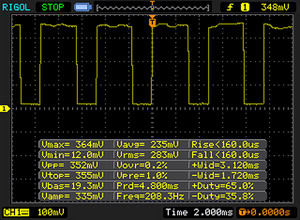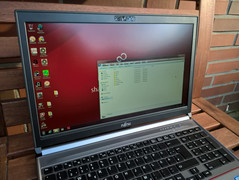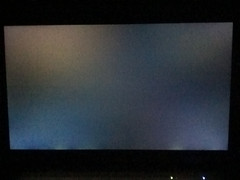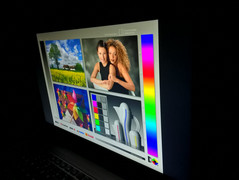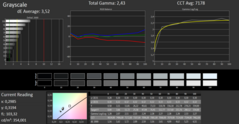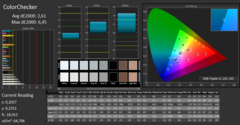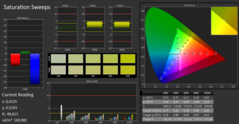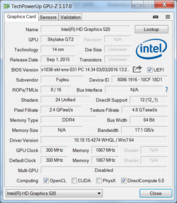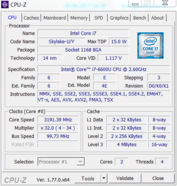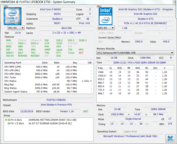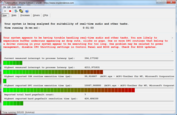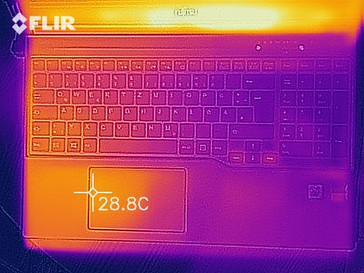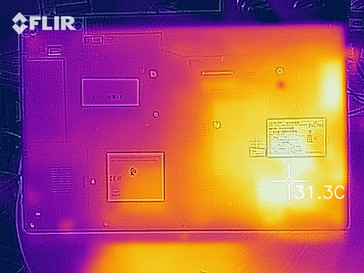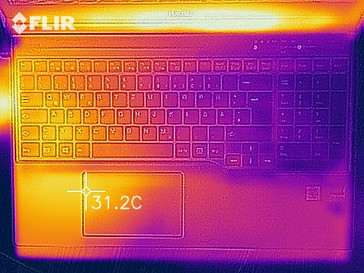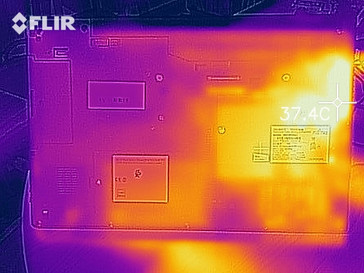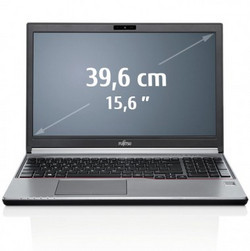Fujitsu LifeBook E756 (i7-6600U, HD520) Laptop Review

For the original German review, click here.
The LifeBook E series is intended primarily for business users. Fujitsu offers the devices in two design variants. The first one comes as a plain, black notebook and the second one as a prestigious silver device. There are plenty of hardware configurations. These range from Intel’s Core i3, i5 and i7 CPUs, various amounts of both RAM and storage space and up to two different display configurations. Various batteries and options for the optical disc drive slot make the LifeBook E756 very versatile.
Our review device comes equipped with the best possible hardware configuration. The Intel Core i7-6600U, Intel’s HD520 graphics unit and 16 GB of RAM ensure sufficient performance. Windows 7 Professional is used as the operating system. An upgrade license to Windows 10 Pro is in the box with the device. This way, the buyers can decide for themselves which version of Windows they prefer to use.
In the review, the LifeBook E756 must prove itself against the similarly-equipped competing devices. These are mostly business devices that are found in the same price range. Lenovo’s ThinkPad T560, the TravelMate P658-M-537B from Acer, the Dell Latitude 15 E5570 and HP’s EliteBook 850 G3 are on the list of the competing devices.
Case & Connectivity
The topside of the display lid and the chassis are made of brushed aluminium. However, the screen bezels and the underside of the LifeBook E756 are made of plastic. With our review device, there are no unusual chinks or gaps to be seen. We also did not hear any creaking noises. All in all, the case appears to be well-made.
There are several maintenance covers on the bottom side of the LifeBook E756. A narrow strip of plastic covers the dust chamber of the cooling unit. When this cover is removed, both the fan and the exhaust vent can be cleaned. Two other covers, each of which is secured with a single screw, offer access to the data storage device and the RAM. The battery and the DVD drive can be removed without a screwdriver. The DVD drive is optional. It can be replaced with a Blu-ray drive, a secondary battery, or an additional storage device.
The ports are very easy to reach. But because they are located very close to the front of the device, working with an external mouse can be made difficult by the mouse plug and the cable. This applies to both right-handed and left-handed individuals. The built-in SD card reader “swallows” an SD card whole.
The Wi-Fi performance falls in line with what one would expect from a wireless card that supports the fast AC standard. Optionally, Fujitsu also delivers the LifeBook E756 with a UMTS/LTE module.
Connectivity
| SD Card Reader | |
| average JPG Copy Test (av. of 3 runs) | |
| Dell Latitude 15 E5570 | |
| Acer TravelMate P658-M-537B (Toshiba Exceria Pro SDXC 64 GB UHS-II) | |
| HP EliteBook 850 G3 (Toshiba Exceria Pro SDXC 64 GB UHS-II) | |
| Fujitsu Lifebook E756 (Toshiba Exceria Pro SDXC 64 GB UHS-II) | |
| maximum AS SSD Seq Read Test (1GB) | |
| HP EliteBook 850 G3 (Toshiba Exceria Pro SDXC 64 GB UHS-II) | |
| Networking | |
| iperf3 transmit AX12 | |
| Fujitsu Lifebook E756 | |
| Fujitsu Lifebook E557 | |
| Lenovo IdeaPad V110-15IKB 80TH001SGE | |
| Acer Aspire 3 A315-21-651Y | |
| iperf3 receive AX12 | |
| Fujitsu Lifebook E756 | |
| Fujitsu Lifebook E557 | |
| Acer Aspire 3 A315-21-651Y | |
| Lenovo IdeaPad V110-15IKB 80TH001SGE | |
Input Devices
Fujitsu has equipped the LifeBook E756 with a chiclet-style keyboard. The keys have a comfortable pressure point and are well suited for prolonged typing sessions. A fully-featured numeric pad makes the keyboard compete. One point of criticism: The special keys, such as “remove”, “paste” and “F-keys” are very small and are positioned very close to each other. Therefore, these cannot be pressed intuitively.
As a replacement for a mouse, the LifeBook E756 uses a ClickPad. It is situated too far to the left, therefore, during typing, the ball of the thumb of the left hand often ends up lying on it. In order to register mouse clicks with the right hand, one will have to move one’s fingers quite a bit to the left. Otherwise, the right mouse button, instead of the left one, is frequently triggered.
Furthermore, the ClickPad does not always properly register double clicks and left mouse clicks. Even after some time with it, we still had to pay attention to where we were clicking and if the click was properly registered.
Display
The buyers of the LifeBook E756 can choose between a Full HD IPS display with a resolution of 1920x1080 and a TN display with a resolution of 1366x768. Our review device comes equipped with the IPS panel. It offers very good viewing angles and great color reproduction.
During our testing, we observed PWM flickering. At 90% of the brightness, the display flickers at about 200 Hz. This can lead to eyestrain among susceptible individuals, during prolonged use. The brightness and the contrast ratio are average, when compared to the competing devices.
| |||||||||||||||||||||||||
Brightness Distribution: 85 %
Center on Battery: 352 cd/m²
Contrast: 729:1 (Black: 0.48 cd/m²)
ΔE ColorChecker Calman: 2.61 | ∀{0.5-29.43 Ø4.78}
ΔE Greyscale Calman: 3.52 | ∀{0.09-98 Ø5}
98% sRGB (Argyll 1.6.3 3D)
64% AdobeRGB 1998 (Argyll 1.6.3 3D)
70.6% AdobeRGB 1998 (Argyll 3D)
98.3% sRGB (Argyll 3D)
68.4% Display P3 (Argyll 3D)
Gamma: 2.43
CCT: 7178 K
| Fujitsu Lifebook E756 SDC3150, , 1920x1080, 15.6" | Lenovo ThinkPad T560-20FH002RGE Panasonic VVX16T028J00, , 2880x1620, 15.6" | Acer TravelMate P658-M-537B LG Philips LGD04D5 / LG Display LP156WF6-SPP1, , 1920x1080, 15.6" | Dell Latitude 15 E5570 LG Philips 156WHU, , 1366x768, 15.6" | HP EliteBook 850 G3 AU Optronics, , 1920x1080, 15.6" | |
|---|---|---|---|---|---|
| Display | -9% | -9% | -40% | -20% | |
| Display P3 Coverage (%) | 68.4 | 64.4 -6% | 66.6 -3% | 40.48 -41% | 54.2 -21% |
| sRGB Coverage (%) | 98.3 | 87.8 -11% | 85.7 -13% | 60.9 -38% | 79.3 -19% |
| AdobeRGB 1998 Coverage (%) | 70.6 | 64.1 -9% | 62.8 -11% | 41.82 -41% | 56 -21% |
| Response Times | 38% | 29% | 17% | 18% | |
| Response Time Grey 50% / Grey 80% * (ms) | 48 ? | 32.8 ? 32% | 38 ? 21% | 47 ? 2% | 46.4 ? 3% |
| Response Time Black / White * (ms) | 40 ? | 22.4 ? 44% | 25 ? 37% | 27 ? 32% | 27.2 ? 32% |
| PWM Frequency (Hz) | 208 ? | 220 ? | 200 ? | ||
| Screen | -25% | -22% | -83% | -71% | |
| Brightness middle (cd/m²) | 350 | 339 -3% | 308 -12% | 228 -35% | 290 -17% |
| Brightness (cd/m²) | 316 | 322 2% | 319 1% | 236 -25% | 287 -9% |
| Brightness Distribution (%) | 85 | 88 4% | 71 -16% | 90 6% | 85 0% |
| Black Level * (cd/m²) | 0.48 | 0.32 33% | 0.61 -27% | 0.56 -17% | 0.54 -13% |
| Contrast (:1) | 729 | 1059 45% | 505 -31% | 407 -44% | 537 -26% |
| Colorchecker dE 2000 * | 2.61 | 5.88 -125% | 4.51 -73% | 10.02 -284% | 9.7 -272% |
| Colorchecker dE 2000 max. * | 6.45 | 11.08 -72% | 10.19 -58% | 15.93 -147% | 14.39 -123% |
| Greyscale dE 2000 * | 3.52 | 7.41 -111% | 2.91 17% | 10.66 -203% | 10.83 -208% |
| Gamma | 2.43 91% | 2.36 93% | 2.4 92% | 2.48 89% | 2.91 76% |
| CCT | 7178 91% | 6036 108% | 6740 96% | 11800 55% | 12761 51% |
| Color Space (Percent of AdobeRGB 1998) (%) | 64 | 57.14 -11% | 56 -12% | 39 -39% | 51.15 -20% |
| Color Space (Percent of sRGB) (%) | 98 | 87.68 -11% | 86 -12% | 61 -38% | 78.96 -19% |
| Total Average (Program / Settings) | 1% /
-13% | -1% /
-13% | -35% /
-61% | -24% /
-49% |
* ... smaller is better
Display Response Times
| ↔ Response Time Black to White | ||
|---|---|---|
| 40 ms ... rise ↗ and fall ↘ combined | ↗ 25 ms rise | |
| ↘ 15 ms fall | ||
| The screen shows slow response rates in our tests and will be unsatisfactory for gamers. In comparison, all tested devices range from 0.1 (minimum) to 240 (maximum) ms. » 97 % of all devices are better. This means that the measured response time is worse than the average of all tested devices (20.2 ms). | ||
| ↔ Response Time 50% Grey to 80% Grey | ||
| 48 ms ... rise ↗ and fall ↘ combined | ↗ 25 ms rise | |
| ↘ 23 ms fall | ||
| The screen shows slow response rates in our tests and will be unsatisfactory for gamers. In comparison, all tested devices range from 0.165 (minimum) to 636 (maximum) ms. » 82 % of all devices are better. This means that the measured response time is worse than the average of all tested devices (31.6 ms). | ||
Screen Flickering / PWM (Pulse-Width Modulation)
| Screen flickering / PWM detected | 208 Hz | ≤ 90 % brightness setting | |
The display backlight flickers at 208 Hz (worst case, e.g., utilizing PWM) Flickering detected at a brightness setting of 90 % and below. There should be no flickering or PWM above this brightness setting. The frequency of 208 Hz is relatively low, so sensitive users will likely notice flickering and experience eyestrain at the stated brightness setting and below. In comparison: 53 % of all tested devices do not use PWM to dim the display. If PWM was detected, an average of 8111 (minimum: 5 - maximum: 343500) Hz was measured. | |||
When compared to the devices that we have selected for comparison purposes, the screen of the LifeBook E756 wins one over, above all, with its very good color space coverage. With 98% for the sRGB color space and 64% for Adobe RGB, our review device surpasses the competing notebooks.
The LifeBook E756 offers enough brightness for outdoor use, although shaded places should be chosen because otherwise the screen contents will be very difficult to read. Thanks to the superb viewing angles, the display of our review device is viewable even from unusual positions.
Performance
At the time of this review, our review device represents the best hardware configuration and comes with an Intel Core i7-6600U CPU, Intel’s HD520 graphics chip and 16 GB of RAM. Therefore, 2D CAD and image editing applications should be usable. However, because 16 GB of RAM comes in the form of a single RAM module, the graphics unit does not benefit from Dual-channel RAM.
Processor
Above all, Intel’s Core i7-6600U processor distinguishes itself through its low TDP. The maximum clock rate sits at 3.4 GHz and is reduced under prolonged loads. The performance drops exhibit a strong correlation to the drops in TDP. In our 30-minute Cinebench loop, the LifeBook E756 exhibits exactly this behavior.
You can learn how well the Core i7-6600U stacks up against other CPUs in our “Benchmarks” section.
When compared to the devices that we have selected for this review, the results of the Cinebench R15 benchmark look good. In the long-running benchmark, the processor exhibits a few performance spurts, however, shortly thereafter the performance drops again. Therefore, in the long run, the available performance is considerably lower.
System Performance
In the PCMark 8 benchmark, the LifeBook E756 achieves good results and takes a spot in the middle of the field. In everyday use, our review device proves to be reliable. All applications start quickly and run smoothly. Furthermore, image editing and multitasking do not slow down the system.
Fujitsu delivers the LifeBook E756 with a preinstalled copy of Windows 7 Professional. However, every device comes with an upgrade key for Windows 10 Pro. Therefore, users can decide for themselves which operating system they would like to use.
| PCMark 8 - Home Score Accelerated v2 | |
| Acer TravelMate P658-M-537B | |
| Fujitsu Lifebook E756 | |
| Dell Latitude 15 E5570 | |
| HP EliteBook 850 G3 | |
| Lenovo ThinkPad T560-20FH002RGE | |
| PCMark 8 Home Score Accelerated v2 | 3284 points | |
Help | ||
Storage Devices
When compared to the competition, the LifeBook E756’s SSD delivers the best results. However, only 380 GB out of 512 GB is available to the user. If this does not suffice, then one can replace the DVD drive with another storage device. By means of a maintenance hatch on the underside of the device, one can also easily replace the existing SSD with another storage device with a larger capacity.
You can compare the supplied SSD with other storage devices on our “Benchmarks” page.
| Fujitsu Lifebook E756 Samsung MZ7TN512HDHP-00000 | Lenovo ThinkPad T560-20FH002RGE Samsung SSD PM871 MZ7LN256HCHP | Acer TravelMate P658-M-537B Kingston RBU-SNS8152S3256GG2 | Dell Latitude 15 E5570 Samsung SSD PM871 MZ7LN128HCHP | HP EliteBook 850 G3 Sandisk X300 SD7SN6S-256G-1006 | |
|---|---|---|---|---|---|
| CrystalDiskMark 3.0 | -10% | -21% | -28% | -19% | |
| Read Seq (MB/s) | 494 | 513 4% | 479.1 -3% | 474.7 -4% | 466.3 -6% |
| Write Seq (MB/s) | 374 | 306.1 -18% | 333.1 -11% | 155 -59% | 426.1 14% |
| Read 512 (MB/s) | 379.6 | 450.6 19% | 418 10% | 393.6 4% | 295.3 -22% |
| Write 512 (MB/s) | 344.5 | 305.5 -11% | 320.5 -7% | 119.7 -65% | 282.1 -18% |
| Read 4k (MB/s) | 37.38 | 33.4 -11% | 25.66 -31% | 34 -9% | 30.42 -19% |
| Write 4k (MB/s) | 120.8 | 85.6 -29% | 64.7 -46% | 96.6 -20% | 80.1 -34% |
| Read 4k QD32 (MB/s) | 393.3 | 346.9 -12% | 226.2 -42% | 383.3 -3% | 326.1 -17% |
| Write 4k QD32 (MB/s) | 338.4 | 278.9 -18% | 211.4 -38% | 100.2 -70% | 162.1 -52% |
Graphics Card
Our review device comes with an Intel HD Graphics 520 GPU. This GPU is not suitable for graphically demanding applications; however, it can run older games smoothly at low resolutions. The performance of the GPU depends on the amount of RAM. Because the LifeBook E756 does not run in Dual-channel mode, it takes last place in the comparison chart below. By adding another RAM module, which can be easily installed through the maintenance hatch, the performance of the GPU can be increased slightly.
How well Intel’s HD Graphics 520 performs in other benchmarks, you can learn in our “GPU benchmarks” section.
| 3DMark 11 - 1280x720 Performance GPU | |
| Lenovo ThinkPad T560-20FH002RGE | |
| Acer TravelMate P658-M-537B | |
| HP EliteBook 850 G3 | |
| Dell Latitude 15 E5570 | |
| Fujitsu Lifebook E756 | |
| 3DMark 11 Performance | 1373 points | |
Help | ||
Gaming Performance
Intel’s HD Graphics 520 can run a few older games at low resolution. Unfortunately, it cannot do much else. In the almost five-year-old “BioShock Infinite”, our review device cannot achieve playable frame rates with the medium settings. The similarly-equipped competing devices give credence to this result. Because the LifeBook E756 was intended to serve as a business device, poor gaming performance should not be a deal-breaker.
Fujistu delivers the LifeBook E756 exclusively with the Intel HD Graphics 520 GPU. You can learn what kind of games it can run in our “Benchmarks” section.
| low | med. | high | ultra | |
|---|---|---|---|---|
| BioShock Infinite (2013) | 43.35 | 22.98 | 18.94 | 5.86 |
Emissions & Energy
System Noise
Under load, the LifeBook E756 is also very quiet and is mostly drowned out by the ambient noise. During normal operation, the fan is barely audible, which means that the notebook is suitable for quiet environments. Most of the competing devices exhibit similarly low noise-levels.
Noise level
| Idle |
| 30.3 / 30.3 / 30.3 dB(A) |
| DVD |
| 34.8 / dB(A) |
| Load |
| 33.5 / 32.5 dB(A) |
 | ||
30 dB silent 40 dB(A) audible 50 dB(A) loud |
||
min: | ||
Temperature
In our stress test, the core temperatures of the i7-6600U exceed the 70 °C mark (158 °F). A subsequent benchmark run, however, did not evince any noticeable drops in performance. And because such loads are almost out of the question in real-life use, there should not arise any problems from the high core temperatures.
The surface temperatures of our review device remain quite moderate. Under load, the notebook reaches some 37 °C (~99 °F) on the underside, which means that one can keep the laptop in one’s lap during work. Most of the competing devices get significantly hotter during operation.
(+) The maximum temperature on the upper side is 29.4 °C / 85 F, compared to the average of 36.9 °C / 98 F, ranging from 21.1 to 71 °C for the class Multimedia.
(+) The bottom heats up to a maximum of 32.8 °C / 91 F, compared to the average of 39.2 °C / 103 F
(+) In idle usage, the average temperature for the upper side is 24.9 °C / 77 F, compared to the device average of 31.3 °C / 88 F.
(+) The palmrests and touchpad are cooler than skin temperature with a maximum of 26.6 °C / 79.9 F and are therefore cool to the touch.
(+) The average temperature of the palmrest area of similar devices was 28.7 °C / 83.7 F (+2.1 °C / 3.8 F).
Speakers
The speakers of the Fujitsu LifeBook E756 reproduce the highs and the mids quite well; however the lows are missing completely. The speakers can be used to reproduce occasional short sounds, but we recommend using external speakers or headphones for listening to music or watching movies.
Fujitsu Lifebook E756 audio analysis
(±) | speaker loudness is average but good (77.1 dB)
Bass 100 - 315 Hz
(-) | nearly no bass - on average 33.6% lower than median
(±) | linearity of bass is average (7.6% delta to prev. frequency)
Mids 400 - 2000 Hz
(±) | reduced mids - on average 8.9% lower than median
(±) | linearity of mids is average (7.5% delta to prev. frequency)
Highs 2 - 16 kHz
(+) | balanced highs - only 3.6% away from median
(+) | highs are linear (5.5% delta to prev. frequency)
Overall 100 - 16.000 Hz
(-) | overall sound is not linear (30.8% difference to median)
Compared to same class
» 96% of all tested devices in this class were better, 1% similar, 3% worse
» The best had a delta of 5%, average was 17%, worst was 45%
Compared to all devices tested
» 89% of all tested devices were better, 3% similar, 9% worse
» The best had a delta of 4%, average was 24%, worst was 134%
Apple MacBook 12 (Early 2016) 1.1 GHz audio analysis
(+) | speakers can play relatively loud (83.6 dB)
Bass 100 - 315 Hz
(±) | reduced bass - on average 11.3% lower than median
(±) | linearity of bass is average (14.2% delta to prev. frequency)
Mids 400 - 2000 Hz
(+) | balanced mids - only 2.4% away from median
(+) | mids are linear (5.5% delta to prev. frequency)
Highs 2 - 16 kHz
(+) | balanced highs - only 2% away from median
(+) | highs are linear (4.5% delta to prev. frequency)
Overall 100 - 16.000 Hz
(+) | overall sound is linear (10.2% difference to median)
Compared to same class
» 7% of all tested devices in this class were better, 2% similar, 91% worse
» The best had a delta of 5%, average was 18%, worst was 53%
Compared to all devices tested
» 4% of all tested devices were better, 1% similar, 94% worse
» The best had a delta of 4%, average was 24%, worst was 134%
Frequency diagram in comparison (checkboxes can be checked and unchecked!)
Energy Consumption
Fujitsu has equipped the LifeBook E756 with a 65-W AC adapter. Because our review device is very energy efficient, this should provide enough power for the device even under load.
| Off / Standby | |
| Idle | |
| Load |
|
Key:
min: | |
Battery Life
In our practically-oriented Wi-Fi test, the LifeBook E756 achieves a runtime of 3 hours and 58 minutes. Therefore, our review device is leagues away from the manufacturer's claim of 14 hours of battery life. With this result, the notebook takes last place among the devices that we have selected for comparison purposes.
Fujitsu offers batteries of various capacities for the LifeBook E756. The optical disc drive can also be replaced with a secondary battery.
| Battery Runtime - WiFi Websurfing | |
| Dell Latitude 15 E5570 | |
| Acer TravelMate P658-M-537B | |
| Lenovo ThinkPad T560-20FH002RGE | |
| HP EliteBook 850 G3 | |
| Fujitsu Lifebook E756 | |
Pros
Cons
Verdict
The LifeBook E756 is a business notebook that impresses, above all, with its many ports and the good maintenance options. The design is simple, but sensible and should be appropriate for any business environment. A wide range of hardware configurations allows one to pick the device that suits one’s needs.
The LifeBook E756 from Fujitsu offers a wide range of ports and maintenance options. Furthermore, performance and ports can be customized to a considerable degree.
The buyers get a notebook with enough performance for most office activities. The LifeBook E756 is not suited for complex 3D applications or games. Those who need a long battery life should get a larger battery or invest in a second battery.
Fujitsu Lifebook E756
- 11/07/2017 v6 (old)
Mike Wobker




